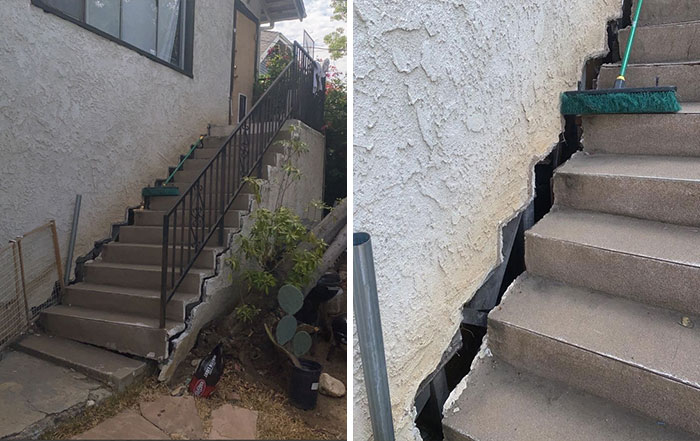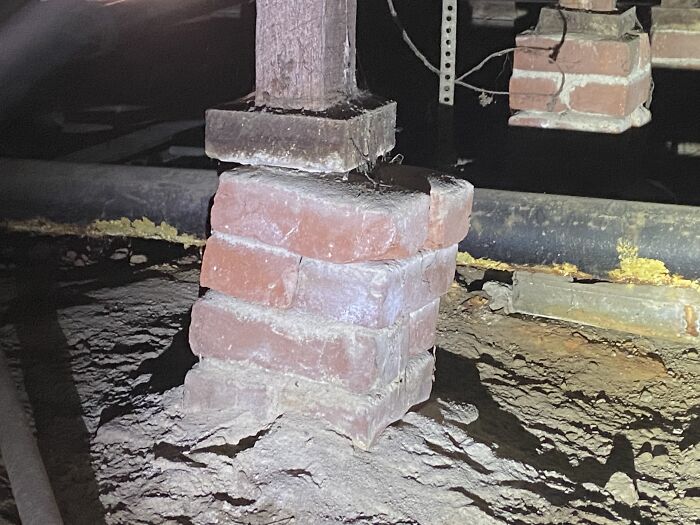
30 Engineering ‘Nightmares’ And ‘Miracles’ Discovered During Structural Inspections By This Company (New Pics)
Real-life adventurers take many forms, from global travelers and nature lovers to tabletop gamers and… structural inspectors and engineers. Don’t believe us? Well, you just have to take a look at the social media accounts of Alpha Structural Inc. to see just how darn interesting their jobs are. The things that inspectors find every day are incredible, from nightmarish cracks to proof that miracles exist because some of these foundations don’t look like they could take a single wobble more. If these photos don’t get your heart racing, nothing will.
Alpha Structural is a company that had been servicing, repairing, and upgrading structures and foundations in Los Angeles and Southern California for over a quarter of a decade. They’ve also got over 400 years of “combined professional experience” in their engineering department alone.
We’ve collected some of Alpha Structural’s most recent photos that they’ve shared online, so go ahead and take a scroll down, Pandas. Upvote the ones that made your jaws drop and let us know how you feel after taking a good long look. When you’ve finished descending and reached the foundation of this list, you can have a look at Bored Panda’s three most recent articles about Alpha Structural right here, here, and here.
A note of warning, dear Pandas: don't do this at home! You have to be a proper structural inspector with the right training, skills, and gear to go poking about creaky building foundations.
More info: AlphaStructural.com | Facebook | Instagram | Twitter | Imgur
This post may include affiliate links.
I don't know about you but I would want to park the furthest away from this wall...
... or anywhere near the whole building. In fact, stay a few miles away from it completely.
The brick and mortar piers are literally turning into dust. Not something you want holding up your entire house.
For one mad moment I thought someone had attempted to plug a gap with chocolate cake
Anyone want to step foot on this balcony?
The frightening thing is we've all already probably stepped on a balcony like this but haven't been in the wrong place at the wrong time... yet...
I’ve personally had the pleasure of having some great in-depth talks with some members of the Alpha Structural team in the past. They’ve been more than kind to explain the ins and outs of their jobs, detail some of the risks they face, and generally help Bored Panda delve into the (sometimes shaky) world of structural inspection. The overwhelming feeling that I got is that this is far more than ‘just a job’ for the team: it’s a calling.
In March 2020, Derek Marier from Alpha Structural told Bored Panda about the “most nightmarish inspection” they’d done that by that point that year. It was a visit to a property in Portuguese Bend down on the Palos Verdes Peninsula. “First off, because of soil conditions and high landslide risks, not much structural work can be performed there," Derek started.
You are looking at the worst framing rot that we have ever come across on an inspection.
You can't even touch this wall without the whole thing falling apart. Just look at the insulation around it!
You know it's really bad when the studs begin to look like fractured vertebrae.
I guess they wanted an open floor plan? They took the brick wall separating the two rooms down. No permits, no contractor, just a man and his trusty hammer.
At least the owner will be able to enjoy a refreshing drink of Squirt as they await rescue
"The home had a very interesting foundation system made up of screw jacks, steel beams, and cribbing (commonly used for temporarily lifting a structure while work is being done underneath). The front portion of the deck and home was sinking and unfortunately, the homeowner can’t really do much about it. It could have toppled over at any given moment and that’s why the 'nightmarish' description fits well," Derek detailed one such truly nightmarish case the Alpha Structural team dealt with.
Structural inspectors take safety very seriously: they take all the necessary precautions to keep their employees safe while out on the job. Derek listed that inspectors wear crawl suits, masks, gloves, and steel-toed boots. They also take many other forms of safety precautions.
Another failing railroad tie "retaining wall" that should be replaced soon. You can see how far it has begun to lean towards the street.
Or maybe it's a bad angle and it is in fact the street that is leaning toward the barrier..... as unruly streets do when left unchecked.
This is a pretty wicked stilt home we inspected this past week. Retrofitting these for earthquakes is one of our many specialties.
I think one more shim should do the job.
“The chance that a building is actually going to fall over when we do our work is slim to none. Any actual danger is sniffed out pretty quick and avoided. If our guys think it’s unsafe to inspect or work on a location, they’ll make a call based on their best judgment and sometimes they choose to not do it. That’s just our safety policy!"
Sometimes, Alpha Structural’s employees will come across truly bizarre finds, like lost or forgotten items, dolls, and even skulls. “You’re expecting to locate a structural defect but end up finding something you can almost label as satanic or ancient,” Derek told me earlier.
There should not be a space here. Never good news when you see stem walls separating at the corner.
at first i thought his hand was his foot so i stared at this picture in utter confusion for a good 5 mins
I didn't realize before this comment... I guess I thought that the weird looking shoe is some kind of safety shoe for construction sites 🤦♀️
Load More Replies...I had the hardest time understanding the picture, I thought it was a foot instead of a hand lol I think I haven't fully woken up yet
Took me a while to realize that was a gloved hand and not a super weird ass shoe
Not good news either that the inspector was wearing sneakers instead of safety boots
Ok. I have a gabled vaulted ceiling in my master bedroom. The seems and sheetrock are started to crack. Why? How much?
Also, it's not foundation. The house past inspection 3 years ago with no foundation issues.
Load More Replies...We weren't able to perform a proper torque test on this bolt... but something tells me we didn't have to.
Here is a brick pier that's sitting dangerously close to a big hole in the ground. Something tells me the homeowner will start to feel some dipping in the floors soon!
One extremely frightening situation Derek found himself in was going into a tunnel that someone had dug under the foundation of a building. “I’ve heard horror stories of people getting trapped under houses by attempting to squirm through those gaps. That’s a nightmare in itself. Thank the lord there was no scary doll or human skull staring me in the face while I was attempting to crawl through!”
It's always nice when I don't have to crawl into a crawlspace but, these stairs are pretty frightening.
Whole lotta issues with this...
Just slightly separating from the structure...
Who knows what's going on here?
These photos are from a home we inspected that was built in 2009. You would think that because it's newer construction the home would be a good shape. Well, this should give you a better understanding of how damaging water leaks can be if they go undetected. Nearly the entire subfloor is rotted from water damage and multiple joists are hanging down from rot.
It took less than a decade for this to occur, so not all homes with significant damage are 100 years old.
Large puddles of water had to be avoided during the crawl as well. (Image 3)
Here you can see two joists hanging down after snapping in half from water damage. (Image 4)
This is probably the nastiest of all the damage. That is not paint. It's possible that the entire subfloor needs to be replaced. (Image 5)
The old lathe and plaster ceilings are sagging, looking like it's about to collapse.
These photos are of severe spall damage underneath an old concrete structure in Los Angeles. This kind of structural flaw occurs after water penetrates the concrete, causing the steel to rust and expand. This breaks apart the concrete and reduces the strength of the area or possibly the entire structure.
We shared these because we wanted owners and managers of these types of buildings to be able to recognize the potential damages that could compromise their structures.
Recently we have been inundated with calls from building owners who are fearful that their buildings could collapse like the condos in Miami. The issues seen in these photos are similar to what was discovered in Miami, among other things.
Whether it's in the ceilings, walls, floors, or columns, and either in the interior or exterior of the structure, these are all signs of significant structural flaws and should always be approached promptly with properly engineered solutions.
Here we have some expansive soil, clearly affecting the foundation already.
Could this just be the soil taking a very deep breath? He asks stupidly!
A customer called us in because of this crack running off the corner of their door, which is never a good sign and points in the direction of foundation problems.
This is what no steel in the concrete and moving soil will do to your foundation.
Someone placed a few shims in there to level it all out.
These balconies have seen better days. As you can see, the wood framing of these balconies is experiencing some deflection. This is why The Balcony Bill exists. The Balcony Bill, formerly known as California Senate Bill 721, was signed into law back in 2018. This bill requires the inspection and possible repairs on all balconies, decks, and stairs that rely in whole or in substantial part on wood structural support in multi-family residential buildings with three or more dwelling units.
Some of the piers weren't even in contact with the posts.
IF "Some of the piers weren't even in contact with the posts," then HOW is the building even standing? Or, is it ...not (standing)???
There appears to be a cave system leading down underneath this home's foundation.
Not sure if this is a structural problem or the beginning of a horror film
This failing retaining wall won't last much longer. Some movement over the years has taken place and has caused the wall to lean into the sidewalk.
Seems like we all could be living in death traps - even the newer homes!
I wish I could have taken some pictures of my Poppy's house before it was sold. They were blast mining in the area, so the foundation got pretty well f****d up. There were huge cracks all over the place, with sagging ceilings and all.
Friend's house was built 20 yeasr ago. He noticed a sag. Contractor crawls in under. The former owner decided to use a jack from a car (as in, the one used when changing a tire) to replace a pier. Yeah, that's working as well as expected.
I used to work for a building inspector, so I have seen things. The most amazing thing was there was a wooden stake in the ground, termites ate their way up the stake and started building their mud track in mid air from the stake up to the floor joists. They had gone about 1 metre up, not quite there when photographed. A big lesson why you never leave wood on the ground under your house. Termites are admirable in how destructive and ingenious they can be.
Just one correction for the article ... I thought it was weird to boast about "more than a quarter of a decade" for experience so I just went to their website. They celebrated 25 years in 2018 so I think it should be a quarter of a century worth of experience. Which makes way more sense.
I'm thinking the average home owner couldn't afford the repairs on most of these. Then what? Any options?
This is what buildings and contents insurance is for and why most mortgage companies write a stipulation requiring said insurance into their mortgage offer
Load More Replies...It’s incredible these places hold for as long as they do. Earthquakes really show the weakness.
I now realise why houses in the US are so much cheaper than here in the UK. Here it is not unreasonable to expect a house to last for at least 50+ years without any major structural problems, houses over 100 years old and still in good condition are still very common.
Agreed, my house in Somerset is about 300 years old and its still very solid, not a single right angle in the whole bloody thing which makes DIY a nightmare, but solid nonetheless
Load More Replies...Eh, I saw plenty worse in Boston while we lived there. First place I lived we took out a chimney brick by brick unassisted by tools beyond protective gloves.
Load More Replies...I used to be an enforcement officer inspecting structures such as these. You wouldn't believe what some people do. They just don't care.
Good thing there aren't buildings older than those regulations or sleazy people who pass the buck. /s
Load More Replies...Seems like we all could be living in death traps - even the newer homes!
I wish I could have taken some pictures of my Poppy's house before it was sold. They were blast mining in the area, so the foundation got pretty well f****d up. There were huge cracks all over the place, with sagging ceilings and all.
Friend's house was built 20 yeasr ago. He noticed a sag. Contractor crawls in under. The former owner decided to use a jack from a car (as in, the one used when changing a tire) to replace a pier. Yeah, that's working as well as expected.
I used to work for a building inspector, so I have seen things. The most amazing thing was there was a wooden stake in the ground, termites ate their way up the stake and started building their mud track in mid air from the stake up to the floor joists. They had gone about 1 metre up, not quite there when photographed. A big lesson why you never leave wood on the ground under your house. Termites are admirable in how destructive and ingenious they can be.
Just one correction for the article ... I thought it was weird to boast about "more than a quarter of a decade" for experience so I just went to their website. They celebrated 25 years in 2018 so I think it should be a quarter of a century worth of experience. Which makes way more sense.
I'm thinking the average home owner couldn't afford the repairs on most of these. Then what? Any options?
This is what buildings and contents insurance is for and why most mortgage companies write a stipulation requiring said insurance into their mortgage offer
Load More Replies...It’s incredible these places hold for as long as they do. Earthquakes really show the weakness.
I now realise why houses in the US are so much cheaper than here in the UK. Here it is not unreasonable to expect a house to last for at least 50+ years without any major structural problems, houses over 100 years old and still in good condition are still very common.
Agreed, my house in Somerset is about 300 years old and its still very solid, not a single right angle in the whole bloody thing which makes DIY a nightmare, but solid nonetheless
Load More Replies...Eh, I saw plenty worse in Boston while we lived there. First place I lived we took out a chimney brick by brick unassisted by tools beyond protective gloves.
Load More Replies...I used to be an enforcement officer inspecting structures such as these. You wouldn't believe what some people do. They just don't care.
Good thing there aren't buildings older than those regulations or sleazy people who pass the buck. /s
Load More Replies...
 Dark Mode
Dark Mode 

 No fees, cancel anytime
No fees, cancel anytime 














































































































